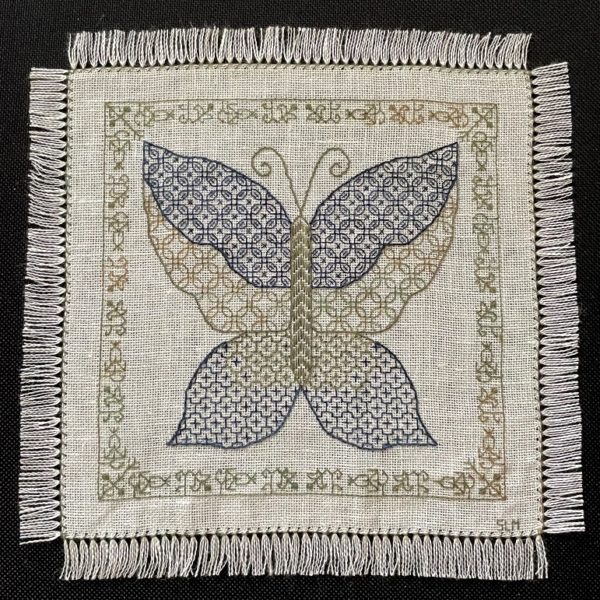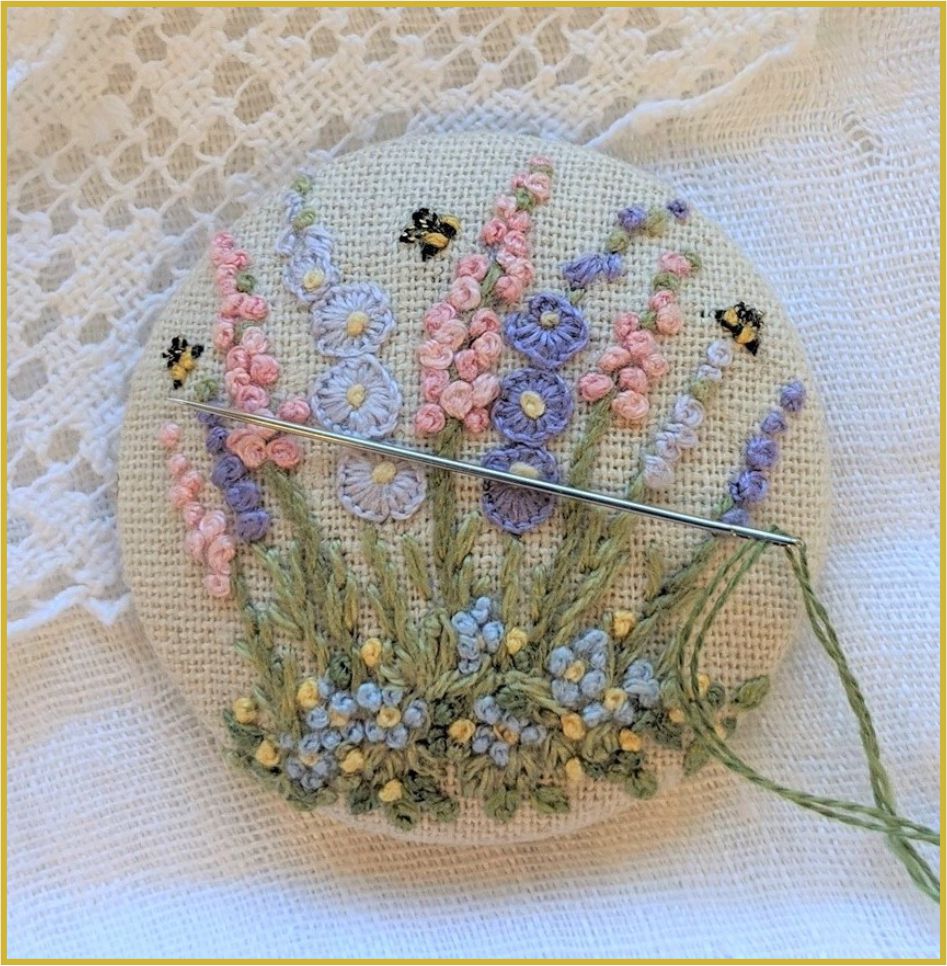Terri Bay’s embroidery practice began in fits and starts: introduced to embroidery as a child, she didn’t find a love for it again until college, and then only later discovered the embroidery niche that would capture her imagination when she inherited unfinished needlework from a beloved aunt. And like many teachers, artists, and creative needleworkers we’ve interviewed before, her passion for Ukrainian Whitework in particular arose out of a lack of options for that style of embroidery. In the pursuit of creating designs, teaching classes, and investigating Ukrainian Whitework techniques, Terri filled a gap in the needlework community, forging a path for needleworkers interested in this particular type of Whitework. We sat down with Terri to learn more about her history and design process ahead of her course, Whitework Windows.

When did you first start embroidering? What were your first experiences with embroidery?
My very first embroidered piece was a clown worked with yarn when I was five or so years old. It was a birthday gift and still hangs on the wall at my parents house. I made quite a lot of clothing for myself in my teenage years, but did not do any embroidery again until I was in college. I was working at a daycare during the summer and needed something to do while the children were napping. A coworker handed me a cross stitch kit and that was that. (Remember those 80’s country geese?) I was hooked.

How did you become interested in Ukrainian Whitework?
My Aunt, Sue Sandi, was a fabulous needleworker and was taking Jan Walter’s Ukrainian Whitework course. Sadly, my Aunt was diagnosed with Pancreatic Cancer and died before she could finish it. I inherited all of her UFOs and most of her stash as she was also a left handed stitcher and no one else wanted to try to match her stitches. It took me quite a while to work up the courage and skills needed to finish it, but I finally did. To my great pride and satisfaction, you cannot tell where her stitches ended and mine began. I loved the technique, but could not find many patterns or books. I began putting my own patterns together out of sheer necessity.

How is Ukrainian Whitework different from other kinds of whitework embroidery?
I like to compare Ukrainian Whitework to Hardanger when asked this question, as many stitchers are already familiar with Hardanger. Ukrainian Whitework is most often edged with hemstitch, or worked on clothing. It is rarely seen with a blanket stitched edging as is very common with Hardanger. It is also primarily a pulled and drawn thread technique and Hardanger is primarily a cut work technique. If you don’t like cutting fabric threads Ukrainian Whitework is much more user friendly than Hardanger.

The other really big thing that sets Ukrainian Whitework apart from other whitework techniques is the use of eyelets. Eyelets are very heavily used and in many, many different forms. There are single eyelets, blanket stitch eyelets, row eyelets, chained eyelets, and spot eyelets to name a few.

What inspired you to start teaching Ukrainian Whitework?
In a nutshell, the wonderful ladies at Nordic Needle. I attended their retreats from the very first one, to the very last one. After a few years, Roz Watnemo asked me if I could teach a Ukrainian Whitework class at the next retreat. I have a degree in education, and had taught in public schools, so I didn’t think that teaching embroidery would be much different. It really isn’t with one big exception. Y’all are a lot more fun and much easier to teach than directing a high school choir. No comparison. I loved teaching from that very first class.

What is something surprising about Ukrainian Whitework that embroiderers who have never worked it before might not know?
I think the biggest surprise is that there are very few cut fabric threads. Usually you will need to cut two to create a channel for a hemstitch. If hemstitch is not included, there probably won’t be any thread cutting at all.

Also, in my opinion, color is okay. If you have trouble seeing white on white, use color. I usually use pearl cotton 8 and 12 making it very simple to change the color. Just grab two balls of pearl cotton in your favorite color and you are good to go.

Is there anything embroiderers should be know before they register for your class Whitework Windows?
The kit is optional. Many students decide to gather their own supplies so they can use whatever color and fabric count they want. I encourage creativity in fabric count and color. 28 is too small for you? Use 25 or 22. I send out a chart that shows which sizes of threads to use with different fabric counts.
There is hemstitching in this one, so you will have to cut and remove a few fabric threads. Not too many, and these are much easier cuts than in Hardanger.

You are teaching 3 courses at EGA National Seminar 2025: Genevieve, a Hardanger project, and Scribbles and Coloring Outside the Lines, both of which combine three techniques—Hardanger, Reticello, and Punto Antico. What inspired you to combine these similar yet distinct embroidery techniques?
I’ve picked up a few books with reticello and have been intrigued with it. The first fusion design I did was Coloring Outside the Lines. Honestly, it pretty much designed itself. The best ones always do. I had a basic Hardanger foundation, Klosters, woven bars, and satin stitching and just felt like going in a different direction. I grabbed some colored pearl cotton and just stitched. Sometimes I have to fight to get designs to do what I want them to do. This one just happened.

Do you have any favorite tools you can’t live without?
My Dovo Hardanger scissors. I cannot do any Hardanger designs without them. My family knows better than to go anywhere near them. They were discontinued, but Silver Needle has had some in stock lately.

A funny story about those scissors: my husband is an engineer and his latest new project run uses tiny little fibers being woven together. He said they needed some scissors to make tiny precision cuts and did I know of any good ones. Yes, he was speaking my language! Once I quit laughing, I lined up eight pairs and had him try them out. The Dovos were his favorite and his company ordered them.

I love my wooden awl. I use it to even out all of those eyelets. It also helps to round them out if they are a bit lopsided and can be used to open up the center holes before stitching.

Do you have a daily/weekly practice that you’d recommend to other embroiderers interested in honing their craft?
Just do it. I can get too wrapped up in planning, or deciding what to do next. Just sit down and stitch.

What crafting or color trends are you drawn to right now?
I love variegated thread. It makes choosing colors so easy. Just find a variegated you love, then pull another color or two to go with it. As someone who normally does white on white, choosing colors can be a challenge.


Where can interested needleworkers discover more of your work and upcoming projects and events?
The first is my website which has my teaching schedule and information. The second is my Facebook page. That is it, I’m not a big social media person.









